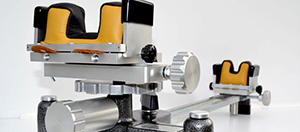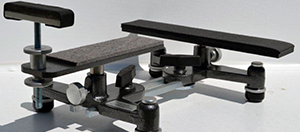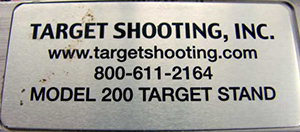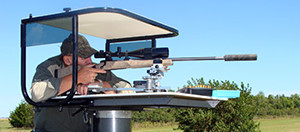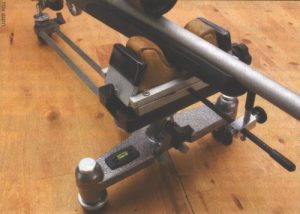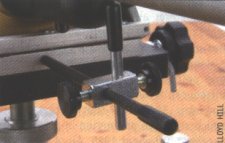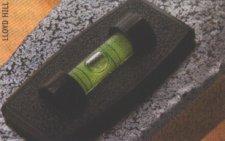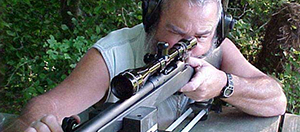I first met Wally Brownlee of Target Shooting, Inc at the 2001 SHOT Show. There he was displaying his new rifle rest, which was called the Model 500. I was impressed enough to buy one on the spot, and have used it for many years. It still serves me well, even though I now also have the newer Model 1000, along with accessories such as the custom-made sandbags for the Model 1000 and the Target Shooting handgun rest. The 500 is still the best choice for some rifles, depending upon the action type and magazine length. For a couple of years now, Wally has been trying to get me out to South Dakota to try out his Model 2500 Shooting Bench. I have seen this bench displayed at shows for a few years now but had never fired off of one until last week. I finally made the trip, along with my cousin Melvin Kent. Most folks around here know him best as Dwayne, but I call him Melvin, as that is his first name. Melvin and I are pretty close as cousins go. He is a first cousin on both sides of the family, as his mother is my father’s sister, and his father is my mother’s brother. Anyway, even though he is a full ten years older than I, we do a lot of things together, and one thing which we have discussed for years is going prairie dog shooting together.
I have received the question more than once; “Why would you want to shoot a cute little prairie dog?” While I will admit that they are cute as far as rodents go, ranchers hate them and want them removed from their rangelands and pastures. The dogs eliminate most of the vegetation around their burrows, and can quickly ruin many acres, with their burrows posing a danger to livestock. Anyway, when we arrived at the ranch in South Dakota, we were welcome guests. Where we were shooting was an area that had seen no recent shooting, but there were also other shooters in the small town of Martin that told of one rancher paying one dollar per dog to anyone that would shoot them.
Arriving the night before we were to go out looking for prairie dogs, the rancher told us that they were having an informal calf roping on the ranch that night, so we gladly attended to watch cowboys, and a couple of cowgirls, compete with each other in a team roping competition. We called it a night around 10 PM, but heard that they were going until around 2 AM the next morning. It was a lot of fun to watch the skill of those folks doing what they grew up doing as if it was all pretty much routine to them.
The next morning, we crawled out of our beds around 6 AM, got dressed, and headed out for breakfast at a place called Jennie’s. I don’t recommend it. The food was pretty good, but the service extremely slow. We were the first customers, but it was a full fifty minutes before the food started to arrive at the table, with the key word here being “started”. It was delivered in waves, instead of all at once. Anyway, the next morning we decided that donuts and coffee from the gas station was a better idea. Heading out of town on a gravel road for several miles, then on a dirt road for several more, we were greeted at the ranch by the owner, who looked as much like Peter Fonda as Peter Fonda does. Really nice fellow, who led us out to the vicinity of the dogs.
Wally handled the set-up of the Model 2500 shooting benches, taking about five minutes to set one up properly. The Model 2500 transports handily in three basic sections. The base with the legs attached weighs around sixty-nine pounds, being made of heavy steel. It still handles very well, as the legs are folded for transport. Wally set up the base and using a small level, adjusted the bench to fit the uneven ground. At the base of each of the three legs is a pad to prevent the legs from burying into the soft ground, and the angle of the legs can be adjusted to precisely fit the terrain. After the base is in place, the table slides on, and it too is adjustable, to allow for any uphill or downhill shooting. Next, the seat attaches, and it is adjustable up and down to fit the desires of the shooter.
The Model 2500 table pivots around its base a full 360 degrees. I found it very useful to slowly pan the area for prairie dogs looking through the scope on the rifle, as well as panning with the Model 2500 when using the binoculars. The table swings freely but has a brake that adjusts the resistance of the table for stability, and the brake can also be completely locked if desired. I left mine set up for just enough resistance for easy panning by pushing off on the footrests.
While on the subject of panning the rangeland with binoculars and through the scope, we used Leupold optics exclusively on this shoot. On my Bushmaster Varminter and Cousin Melvin’s Ruger Mini-14, we mounted VX-L scopes. The dished out bottom on the VX-L makes it really the only choice for varmint hunting with a Mini-14, due to the high handguard over the barrel. The VX-L, even with its large objective bell, mounts low on the Mini for a better cheek-weld on the stock, improving the practical accuracy of the weapon. The Leupold scopes we used had the Varmint Hunter’s reticle, which proved to be very useful at extended ranges, with the reticle subtentions having windage hold-off points to make hitting much easier with the gusting winds. When looking through a scope or binoculars all day, good glass makes a world of difference, and the Leupold binoculars and scopes never caused any eye fatigue at all. I have used cheap scopes in the past, but if I can help it, I will never do so again. Quality optics cost more because they are worth it. The Leupolds never let us down, and never failed to provide excellent resolution, even out past 400 yards. I am not certain how many rounds I fired over the course of two days shooting, but it was several hundred. The scope settings never moved but remained precisely set to where I wanted.
After the benches were set up on the first morning, the shooting was slow. There were prairie dog burrows on the hillside across from us, but very little activity. It was decided that Cousin Melvin and I would get into the Gunblast Suburban and go try to find some better ground. After checking a few places, taking a dog or two then moving on, we crested a ridge and looked into the valley below. Jackpot! There were burrows and dogs everywhere. Having left the benches behind with Wally and his video guy, Bob Saur, we shot a few dogs, resting our rifles on the truck. The wind was moving the truck, so I decided to go into a semi-prone shooting position, which was better, but the stability just was not good enough for hits much past 200 yards. After a dandy dinner (“lunch” for you folks north of the Mason-Dixon), we moved the benches and set them up in the newly-named Prairie Dog Valley. Once we were on the Model 2500 shooting benches, our hit percentage went way up. I could not believe what a difference it made. Panning the valley and the opposing hillside was easy, swinging the table towards a dog as soon as he was spotted. The bench, with the Target Shooting, Inc Model 1000 rest atop, was as stable as my heavy benchrest at home. The crosshairs of the Leupold would settle on a target, and stay absolutely still using the bench. The solidity of the shooting bench and the comfort of the shooting position allowed me to spot my misses through the rifle’s scope, and make windage and elevation adjustments instantly. I carried two AR-15 rifles with me on this trip; my Varminter and a new Anderson Manufacturing AM-15 with my Tactical Solutions can be attached to the muzzle. Both rifles performed splendidly using Black Hills and American Marksman Stryker ammunition.
For the rest of the day, we shot prairie dogs constantly, only stopping occasionally to let the rifles cool. Melvin’s Mini got so hot that it was starting to lose accuracy, so a wet towel was placed over the barrel to speed the cooling. The Varminter’s fluted barrel cooled very well, as did the barrel of the AM-15. For this type of fast action, I really love the AR rifles. Between shots, there is no need to work a bolt or to even move the shooter’s eye away from the scope. Aiming corrections can be made instantly, and the twenty-shot mags that I prefer are both handy and reliable. Recoil is light, and the accuracy was superb using the ARs. Several hits were made out past 400 yards, even with the wind blowing.
The bench that I was using had the optional canopy that Wally had just developed. It shades the shooter and his weapon from the hot sun, and the wind did not seem to affect it at all. It fastens securely to the bench top, so there is no extra time needed to set up the Model 2500 for shooting.
The next morning we arose early, grabbing a quick breakfast at the gas station, and headed off to a different ranch, met once again by a friendly rancher who was glad that we were there. We once again found a good shooting area, but this time it was flatter ground than where we shot the day before. The benches really worked out well on that ground as well. Panning a full 360 degrees to acquire targets was very easy, and the stability of the rifles on the bench and rifle rest was as good as it gets. This Model 2500 bench really impressed me. I had expected it to be good, but I have used portable benches before, and they were sorely lacking in quality and stability. The Model 2500 was just like being on a heavy concrete bench at the range, except that the Model 2500 is a lot easier to use, more versatile, and much more comfortable.
While the price of the Model 2500 shooting bench is higher than many of the cheaper benches available, it is because the Model 2500 is that much better. It offers rock-solid stability, extreme versatility, and absolute comfort. When figuring the cost of the bench against the cost of the trip, and considering that it will last more than a lifetime, the cost is minimal. The Model 2500 bench and all of Target Shooting’s products are made of top quality materials, beautifully finished, one hundred percent weather-proof, and are made in the USA. For pricing and ordering information, go to www.targetshooting.com.
For a look at the quality Leupold optics, go to www.leupold.com. For a look at the Black Hills and Stryker ammo used on this shoot, go to www.black-hills.com and www.americanmarksman.com. Look for a review here soon on the high-quality AM-15 rifles from Anderson Manufacturing. By the way, in that picture of Wally cooking and us chowing down, the meat is not really prairie dog. We had decided on the way out to South Dakota that we would cook up a couple and try them, but when we bought our hunting licenses, the literature from the state warned against handling the animals, as they can carry the bubonic plague, which can be transferred to humans by fleas. Wally cooked up the best pork ribs that I have ever eaten, and I have stuffed a lot of ribs down my neck in my short life. Thanks, Wally and Bob, for the grub, the guidance, and the friendship. It was a good prairie dog shoot. The equipment made all the difference, and if I can help it, I will never go shoot prairie dogs again without a Model 2500 shooting bench.












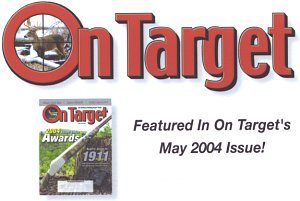
 Made in the heartland of the U.S.A, Watertown South Dakota.
Made in the heartland of the U.S.A, Watertown South Dakota.


